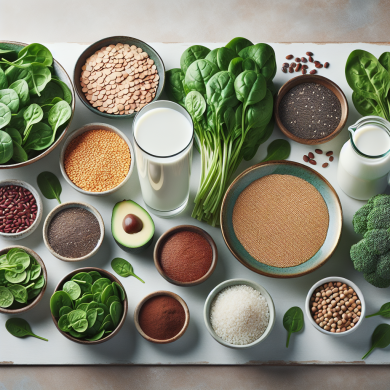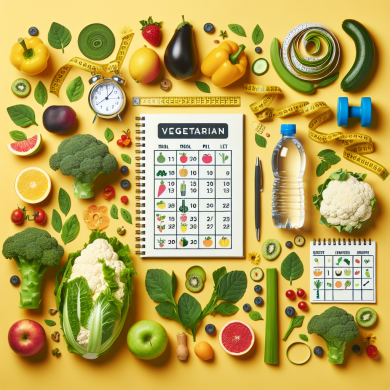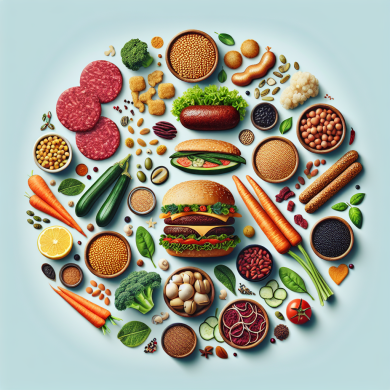Dairy vs. Non-Dairy: Vegetarian Choices Explored
Introduction
The rise of vegetarianism has led many to reevaluate their dietary choices, particularly concerning dairy consumption. With a significant portion of the global population being lactose intolerant and an increasing awareness of ethical and environmental issues, non-dairy alternatives are gaining popularity. This article delves into the nutritional, ethical, and environmental aspects of dairy and non-dairy options, providing a comprehensive guide for those exploring vegetarian choices.
Nutritional Comparison
Dairy Nutrition
Dairy products, including milk, cheese, yogurt, and butter, are well-known for their rich nutritional profile. They are excellent sources of calcium, which is essential for bone health, as well as vitamin D, vitamin B12, potassium, and high-quality proteins. The fat content in dairy varies, with options ranging from full-fat to low-fat and fat-free products.
The proteins in dairy are complete, meaning they contain all nine essential amino acids needed by the human body. Dairy is also an important source of riboflavin and phosphorus, contributing to overall nutritional balance.
Non-Dairy Nutrition
Non-dairy alternatives have expanded beyond soy to include almond, oat, coconut, rice, and cashew milk, among others. These alternatives are often fortified with calcium, vitamin D, and vitamin B12 to mimic the nutritional benefits of cow’s milk. However, the protein content can vary significantly between different non-dairy options.
For example, soy milk comes closest to cow’s milk in terms of protein content, while almond and rice milk have considerably less protein. It’s important for consumers to check labels to ensure they are meeting their nutritional needs, especially if they rely on non-dairy milk as a primary source of calcium and vitamin D.
Ethical Considerations
Dairy Production Ethics
Ethical concerns surrounding dairy production often focus on animal welfare. The conventional dairy industry has faced criticism for the treatment of cows, including issues related to living conditions, milking practices, and the separation of calves from their mothers. These concerns have prompted some vegetarians to seek out alternatives that align better with their ethical values.
Organic and pasture-raised dairy options are available for those who wish to continue consuming dairy but are concerned about animal welfare. These products typically adhere to stricter standards regarding animal treatment and do not involve the use of synthetic hormones.
Non-Dairy Ethics
Non-dairy alternatives often position themselves as more ethical choices, primarily due to the absence of animal exploitation. However, the production of plant-based milks is not without its own ethical considerations. Issues such as water usage, land use, and the environmental impact of transporting ingredients can influence the sustainability of these alternatives.
For instance, almond milk has been scrutinized for its high water consumption, particularly in regions affected by drought. Consumers seeking ethical non-dairy options should consider the broader environmental impact and choose products from companies committed to sustainable practices.
Environmental Impact
Environmental Footprint of Dairy
The environmental impact of dairy production is significant, contributing to greenhouse gas emissions, water usage, and land degradation. Cattle farming is a major source of methane, a potent greenhouse gas, and the resources required to sustain dairy operations are considerable.
Efforts to mitigate the environmental footprint of dairy include improving feed efficiency, manure management, and adopting more sustainable farming practices. However, the scale of dairy production continues to pose environmental challenges.
Environmental Footprint of Non-Dairy
Plant-based milks generally have a lower environmental footprint compared to dairy, with reduced emissions and water usage. However, the environmental impact varies among different non-dairy options. For example, oat milk is often highlighted for its relatively low environmental impact, while coconut milk’s production may involve significant transportation emissions due to tropical sourcing.
Consumers interested in minimizing their environmental impact should consider the entire lifecycle of the product, including sourcing, production, and distribution. Opting for local and sustainably produced non-dairy options can help reduce the overall environmental burden.
Health Implications
Dairy and Health
Dairy has long been associated with health benefits, including bone health and reduced risk of certain diseases. However, some individuals experience lactose intolerance, an inability to digest lactose, the sugar found in milk, leading to gastrointestinal discomfort.
For those able to tolerate it, dairy can be part of a balanced diet. However, it’s important to consider fat content and opt for low-fat or fat-free options if concerned about cardiovascular health.
Non-Dairy and Health
Non-dairy alternatives are suitable for those with lactose intolerance or dairy allergies. They also cater to individuals following vegan diets. However, it is crucial to choose fortified options to ensure adequate intake of nutrients like calcium and vitamin D, which are naturally abundant in dairy.
Some non-dairy milks contain added sugars or thickeners, so it’s advisable to choose unsweetened and minimally processed products. Additionally, those relying on non-dairy alternatives should ensure they get enough protein from other sources if their chosen milk is low in protein.
Culinary Uses
Dairy in Cooking
Dairy products play a versatile role in cooking, offering creaminess, flavor, and texture to a wide range of dishes. Milk can be used in baking, sauces, and beverages, while cheese and yogurt are staples in many cuisines worldwide.
The melting properties of cheese and the fermentation of yogurt add unique culinary elements that can be challenging to replicate with non-dairy options. However, advances in food technology have made it easier to find non-dairy alternatives that mimic these properties.
Non-Dairy in Cooking
Non-dairy alternatives have become increasingly sophisticated, allowing for greater culinary flexibility. Almond milk, oat milk, and coconut milk are popular choices for baking and smoothies, while non-dairy cheeses and yogurts offer alternatives for those avoiding animal products.
The key to successfully using non-dairy options in cooking is understanding their unique properties and how they interact with other ingredients. Experimenting with different brands and types can help achieve the desired taste and texture.
Conclusion
The choice between dairy and non-dairy options is multifaceted, involving nutritional needs, ethical considerations, environmental impact, health implications, and culinary preferences. Both dairy and non-dairy products can have a place in a vegetarian diet, depending on individual priorities and values.
As awareness grows and options expand, it is easier than ever for vegetarians to make informed choices that align with their health goals and ethical beliefs. Whether choosing dairy or non-dairy, the important thing is to ensure a balanced and varied diet that supports overall well-being.















Add comment